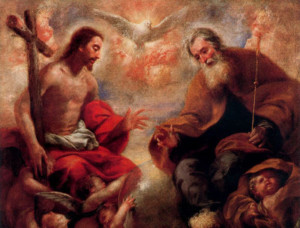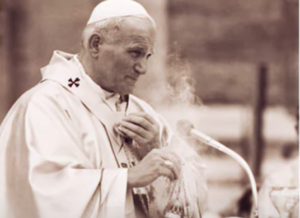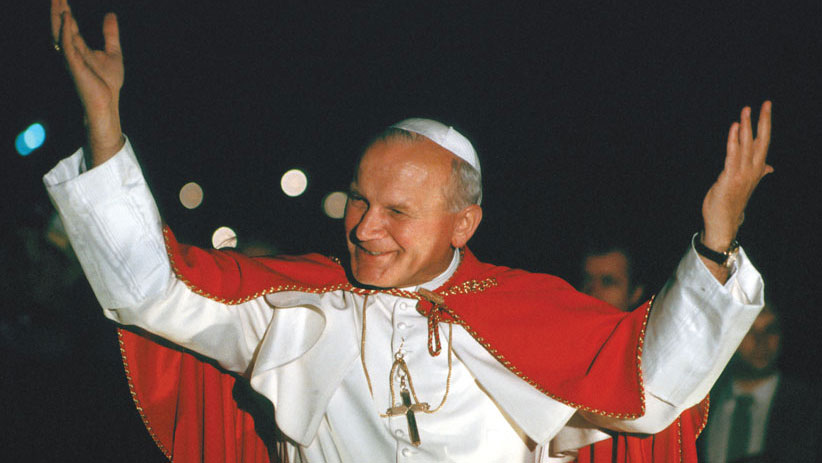In honor of St. John Paul II’s feast day (October 22), Katrina adapted a recent talk entitled, “Four Life-Changing Nuggets from St. JPII.” In this blog, she only covers 3 nuggets, but if you’d like a pdf of the whole talk, please email our JPII Resource Center assistant, Zelda (zgraham@dphx.org) and request a copy. And please “share” this on your social media sites so all can be blessed by St. JPII’s insights.
***
Over the past twenty years, I’ve been asked numerous times what makes St. John Paul II’s Theology of the Body new or different. Cardinal Marc Ouellet, in a talk honoring the newly minted St. John Newman, pointed out, “…although the deposit [of faith] does not change, the Church’s knowledge of it progresses, deepens, and is expressed in a new way, always faithful to the original idea.”
Cardinal Ouellet’s words are an excellent description of St. John Paul II’s theology as well. Through his emphasis on human embodiment, starting with the “beginning” in Genesis and continuing all the way to Christ’s glorious Second Coming, St. John Paul II deepens the deposit of faith. I’d like to look at three profound ways he does this through what I call “Life-Changing JP2 Nuggets.”
JP2 Nugget #1: You are made in the image and likeness of a Trinitarian God, otherwise known as a Trinitarian anthropology.
 Being made in God’s image and likeness is a basic tenet of Christianity (see Genesis 1:27). In fact, the Catechism of the Catholic Church #261 says this about the Trinity: “The mystery of the Most Holy Trinity is the central mystery of the Christian faith and of Christian life.” And yet, most Christians have never thought of being made in the image and likeness of a Trinitarian God.
Being made in God’s image and likeness is a basic tenet of Christianity (see Genesis 1:27). In fact, the Catechism of the Catholic Church #261 says this about the Trinity: “The mystery of the Most Holy Trinity is the central mystery of the Christian faith and of Christian life.” And yet, most Christians have never thought of being made in the image and likeness of a Trinitarian God.
In his fabulous book, Contemplating the Trinity, Fr. Raniero Cantalamessa OFM, the papal preacher, says, “Every Christian presentation about God should have a trinitarian character; in this regard there is still much to be done.” I heartily agree. Every person, Christian or atheist, needs a more robust image of God as Trinity than is usually offered by images such as a shamrock, water in three different states (solid, liquid, gas), or an old man, a young man, and a bird. These explanations seriously lack an authentically relational dimension that we can imitate.
St. JPII wants to change all that. Over the years, I developed a description of the Trinity drawing from Pope John Paul II’s writings that emphasize union, communion, and gift. I’ve seen this description engage people’s imagination so that, suddenly, the inner life of the Trinity becomes meaningful and relatable to their own life. Here it is:
“The Father pours himself out in a total gift of love to the Son. The Son pours himself out in a total gift of love to the Father and the Holy Spirit bursts forth/overflows as the fruit of their total, self-giving love.”
The clearest expression of St. JPII’s Trinitarian anthropology is found in his apostolic letter, “On the Dignity and Vocation of Women,” no. 7. In this section, St. JPII wrote: “…the New Testament will reveal the inscrutable mystery of God’s inner life…. [T]he unity of the Trinity: unity in communion. In this way new light is also thrown on man’s image and likeness to God…” Man and woman “are called to live in a communion of love, and in this way to mirror in the world the communion of love that is in God…” Every person is created to mirror the Communion of Love that is the essence of the Trinity, but how do we do this?
Through JP2 Nugget #2: You are a gift!
 If Nugget #1 is a Trinitarian anthropology, then Nugget #2 is a gift ontology. Or put another way: You are created as a gift to be a gift. Every person comes into the world as a gift. This is the core of our human essence. But how can this “gift essence” be universally true when we know not every person’s conception is a celebrated event?
If Nugget #1 is a Trinitarian anthropology, then Nugget #2 is a gift ontology. Or put another way: You are created as a gift to be a gift. Every person comes into the world as a gift. This is the core of our human essence. But how can this “gift essence” be universally true when we know not every person’s conception is a celebrated event?
It’s because the origin of every person occurs first in the Trinity. Every person’s existence originates in the overflow of the Gift of Love between the Father and Son in the Holy Spirit. Your very existence in the world is a visible and embodied sign of the Trinitarian Overflow of Love in Self Gift. As a result, before you ever “do” anything, you are a gift. And, since you are a gift, then you are created to be a gift. St. JPII described this quite clearly in “On the Dignity and Vocation of Woman,” no. 7: “To say that man [the human person] is created in the image and likeness of God means that man is called to exist ‘for’ others, to become a gift.”
A Catholic grade-school teacher I’ve been mentoring is working diligently to integrate the language of gift into her 1st grade classroom. A couple weeks ago, she sent me this text: “Today a boy said, ‘I don’t want to sit by all the girls’ and I went on to explain how God gave Eve and every woman, every person, as a gift, therefore the correct response should be, ‘Wow! Thank you, God for all of these girls that You have given as a gift to me and everyone!’ There were no more complaints after that. Ha ha!”
It’s no exaggeration to say this gift ontology could change the world. St. JPII thought so. That’s why he adopted a quote from the Vatican II documents as the centerpiece of his writings: “Man…cannot fully find himself except through a sincere gift of himself” (Gaudium et Spes, no. 24). This is why I sign all my emails, “You are a gift!” and why I end every TOB Tuesdays with, “And remember…you are a gift!”
Well, you might be thinking, Trinitarian anthropology and gift ontology might be nice for this temporal world, but they really don’t have much application to life after death. Our ultimate end or telos differs radically from this life. And that leads to…
JP2 Nugget #3: Get used to your body because it will be with you for all eternity!
 This is a shocking statement to many people, Christians included. I would estimate about 80% of Catholics have never heard of the resurrection of their body. They’ve never heard “the hit-you-between-the-eyes” truth that their body, the body sitting in that chair, is going to heaven with them.
This is a shocking statement to many people, Christians included. I would estimate about 80% of Catholics have never heard of the resurrection of their body. They’ve never heard “the hit-you-between-the-eyes” truth that their body, the body sitting in that chair, is going to heaven with them.
This is rather curious since the first proclamation of the Apostles was “Christ is risen!” Why, then, has the resurrection of the body dropped out of common Catholic knowledge? I think one reason is that most churches pray the Nicene Creed on Sundays, which says, “We look for the resurrection of the dead…” As a result, many people don’t connect “resurrection of the dead” with their own glorified body. For many people, the soul goes to heaven and the body stays behind, permanently.
Secondly, our typical language regarding salvation and heaven is anything but embodied. For instance, have you ever heard any of these statements (or something similar):
- “…please lead all souls to heaven, especially those most in need of Thy mercy.”
- “May we imitate St. Maximilian Kolbe’s zeal for souls.”
- “The salvation of souls is the supreme law of the Church.”
In all these statements, the soul alone is described as the recipient of salvation without any reference to the body or our eternal embodiment. The metaphysical truth that human persons are a body-soul unity is missing from our common view of salvation. Consequently, it’s shocking for many people to hear that their body has an eternal relationship with their soul that will not be discarded in heaven but perfected.
Why does this matter? Because if we overlook the redemption of the body, then we also overlook scriptures such as Romans 8:22-23, which says: “We know that the whole creation has been groaning in labor pains until now; and not only the creation, but we ourselves, who have the first fruits of the Spirit, groan inwardly while we wait for adoption, the redemption of our bodies.”
Creation is awaiting the redemption of our bodies because our bodily redemption is the promise that Christ came to redeem all of creation. Hollywood gets it wrong – in the end, everything doesn’t get blown up in an apocalyptic disaster. The ultimate end and purpose of history is the return of the Glorified and Embodied Divine Bridegroom, who inaugurates a new heaven and a new earth so that all of creation, including our bodies, reach their final fulfillment, not their final decimation.
But there’s another reason why the glorified body is important. St. Paul brilliantly identifies the human body as a temple of the Holy Spirit in 1 Corinthians 6:19-20. In this passage, he announces: “Do you not know that your body is a temple of the Holy Spirit, who is within you? You are not your own. You were bought with a price. So, glorify God in your body.”
For the Jews, the Temple was the one place where Yahweh dwelt visibly, tangibly. To say the human body is a temple of the Holy Spirit means our entire embodied person, not just the soul, is in-dwelt by the Spirit. Sadly, though, if we think the Holy Spirit inhabits only our immaterial soul without reference to the body, then we can slip into disassociating the soul from the body and think it really doesn’t matter what happens to our body. (For more on the relationship between body and soul, see TOB Tuesdays Blog #6, “Christmas is a wedding!”)
This alienation of the body from the soul is a tragic falsehood, a debilitating fiction since the opposite is true: what happens to your body, happens to you. You don’t have a body; you are your body. This is why we need to rework our understanding of human happiness and salvation here on earth and for all eternity in terms of embodied personhood – we need an embodied teleology.
Instinctively, you know what teleology is: Christ has died, Christ is risen, Christ…? Will come again.
Christ coming again is what the Catholic faith means by teleology – the ultimate end, goal, and purpose of human life. And St. JPII makes an embodied teleology the high point of his Theology of the Body. In Audiences 66-68, he joyfully describes how we are created for embodied union and communion with the inner life of the Trinity in our glorified bodies for all eternity. This is our faith, the faith we profess!
 At his first Mass as Pope on October 22, 1978 (which is why this date is his feast day), St. John Paul II famously proclaimed: “Do not be afraid. Open wide the doors for Christ.” Perhaps we, too, can respond to that call by opening wide the door of our hearts to St. John Paul II’s three life-changing nuggets – a Trinitarian anthropology, a gift ontology, and an embodied teleology.* In doing so, we can keep St. John Paul II’s legacy alive for present and future generations by imaging a Trinitarian God through union and communion, by living our “gift essence” as our deepest identity, and by receiving and rejoicing in the redemption of our human embodiment both in this life and for all eternity. And through these three life-changing JP2 nuggets, the whole world – not just Catholics – will rediscover the meaning and beauty of eternal human embodiment. And remember…you are a gift!
At his first Mass as Pope on October 22, 1978 (which is why this date is his feast day), St. John Paul II famously proclaimed: “Do not be afraid. Open wide the doors for Christ.” Perhaps we, too, can respond to that call by opening wide the door of our hearts to St. John Paul II’s three life-changing nuggets – a Trinitarian anthropology, a gift ontology, and an embodied teleology.* In doing so, we can keep St. John Paul II’s legacy alive for present and future generations by imaging a Trinitarian God through union and communion, by living our “gift essence” as our deepest identity, and by receiving and rejoicing in the redemption of our human embodiment both in this life and for all eternity. And through these three life-changing JP2 nuggets, the whole world – not just Catholics – will rediscover the meaning and beauty of eternal human embodiment. And remember…you are a gift!
* These three “ology” terms can be defined as follows:
- Anthropology: The broad study of humankind. I am using it here in the more specific sense of what characterizes or defines human beings as a distinct species.
- Ontology: The study of the nature or being (essence) of a thing.
- Teleology: The study of the created world in terms of the purpose or end toward which a thing strives or is ordered/designed.
© by Katrina J. Zeno, MTS




